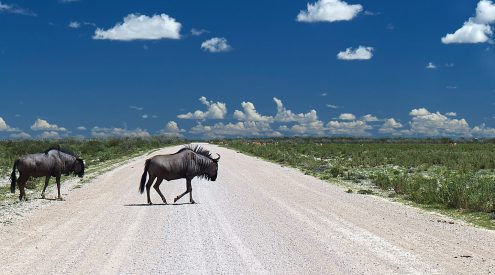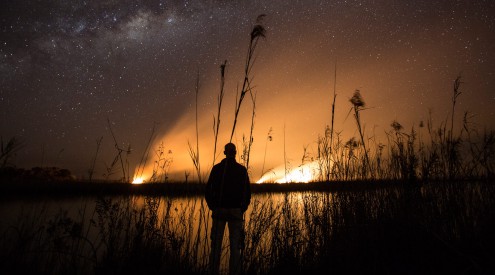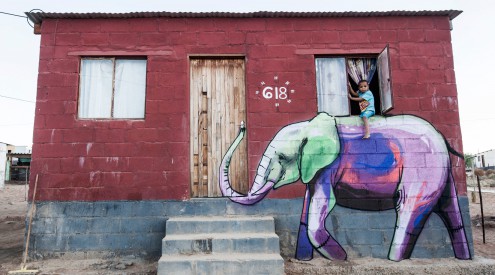If your life were to flash before your eyes right now, what would you see? This is the question often asked by Put Foot Rally founder Daryn Hillhouse. Inspired by the mad antics of Europe’s famous – or rather infamous – Mongol Rally, Daryn set about creating an African equivalent.
Participants in the Mongol event drive “˜totally unsuitable cars’ thousands of miles from London and other parts of Europe to Ulan Bator, Mongolia, for charity. Hence the premise: would a similar Southern African event work equally well? And the answer is a resounding yes.
Which brings me to the inaugural Put Foot Rally. The mix of vehicles, from a couple of Citi Golfs, an indefatigable Datsun 120Y, a 1960s Landy and, of course, a healthy sprinkling of luxury 4x4s – including our 4×4 Megaworld-sponsored VW Amarok – serves as a testament to the wide appeal of this event. After all, isn’t there a little longing in all of us for the days when “˜seven countries, seven checkpoints, seven parties in 17 days’ was, like, the most incredible idea ever?
The Put Foot plan is simple: to encourage a new generation of travellers and those who have, for one reason or another, failed to grasp their adventurous spirit and head out to explore their own backyard. Most importantly the message is clear: you don’t need an expedition-ready 4×4 to explore most of Southern Africa. Almost the entire route through South Africa’s neighbouring countries is tarred or at least passable, accommodation and supplies are abundant and, perhaps most importantly, it doesn’t need to cost the Earth.
On your marks
Leaving from two starting lines, one in Cape Town and the other in Johannesburg, all 25 participating cars with a total of 125 people took in the Fish River Canyon before filtering into checkpoint one for a party at the Etosha Safari Camp three days later.
And that’s how the event rolls. Fixed checkpoints ensure you have all the information and encouragement you need, while giving you enough time to explore on your own. The intention isn’t to become an onerous guided tour across the subcontinent. As it worked out, three days evidently is enough time for the adventure to kick in and many of our fellow Put Footers already had many stories, mostly of bad planning and haphazard navigation, to share at the first checkpoint.
Far from smug travel-hardened veterans, we had to smile and wave quietly, having gotten lost in our hometown. It’s not all plain sailing. Having escaped the Edgemead triangle we made it all the way to Rehoboth where we discovered our stretcher beds didn’t fit into our tents. Consequently Team Getaway (Christie Fynn, videographer Stu Cooper and myself) spent an awfully long n-night b-begging d-dawn to arrive before the -5ºC conditions froze us solid in our frost-encrusted sleeping bags. Luckily help was at hand – our K-Way sponsored sub-zero-rated sleeping bags staved off the worst of the cold – and, as if to ease our “˜suffering’, Etosha Safari Camp staff went to great lengths presenting a monster buffet with perfectly prepared venison, endless supplies of rum-and-raspberry drinks and music to firewalk by. The bonfire pit was still smouldering as the teams crept battered and boozed out of camp to begin the second leg by exploring Etosha National Park.
The treasures of Etosha, surviving a mock-charging elephant and more bad navigation conspired to make us arrive at Kupferquelle Resort in Tsumeb long after dark. (Come to think of it, we never really mastered the navigation.)
A typical day out
Roads throughout most of the trip were so good that our fully kitted VW Amarok truly was overkill. The double cab purred along and life on the road quickly took on a rhythm of breaking camp, driving, finding or making food along the way (sardine roll, anyone?) and taking in as many attractions as time allowed. Although distances averaged about 400 kilometres a day, speed limits and stops for photos, food and village speed humps – and kids of the two- and four-legged kind – stretched the journey into a whole-day affair.
By the time we reached the third checkpoint at the Zambezi Waterfront in Livingstone on day seven, we’d driven almost constantly and were ready for a bit of downtime. So far we’d stayed in treehouses, booze-cruised the Kavango panhandle, crossed the Caprivi Strip and spent one raucous night at the checkpoint at Chobe Safari Lodge; it proved the perfect setting. In Put Foot terms, downtime meant not having to drive. But you’re dreaming if you think you can go to Livingstone, Africa’s adrenaline capital, and just chill out. Put Footers took days out of their planned itineraries to bungi jump, booze cruise, take helicopter flips, white-water raft, walk with lions and enjoy elephant-back safaris. The Zambian checkpoint party was extra epic, not only because the organisers had flown in thorax-ache-inducing comedian Paul Snodgrass and the rocking band Me and Mr Brown to entertain us, but we also participated in a shoe drop at the local school.
Teams formed a procession and brought the gobsmacked town to a halt as we delivered 200 pairs of shoes to the kids at a Livingstone primary school. Many seemed bewildered by the sudden flood of mzungus bearing gifts. Tony King, operations manager of Safari Par Excellence, had gone to incredible lengths arranging proceedings in Livingstone, not least of which was getting a military marching band to lead the convoy into the school for the charity shoe drop.
What good is it?
Believe it or not, the Put Foot Rally isn’t all about road tripping and hedonism. Like the Mongol Rally, the crews are expected to raise money for a good cause. This year, the Bobs for Good Foundation, which endeavours to put shoes on the feet of some seven million African kids, were the beneficiaries. Some teams held fundraisers prior to the start of the rally and others didn’t let the lack of reliable comms on the road thwart their fundraising efforts. To top it all, Old Mutual generously pledged to double the final total collected and must have been a little bemused to have to match the R150 000 Put Footers raised. And if the emotion evoked by those few hundred pairs of donated shoes is anything to go by, the R300 000 the Put Footers ultimately raised is going to fill valleys with joyful weeping. Not a bad effort for a motley band of rapscallions (and some ladies).
Having paused to “˜adrenalate’ in Livingstone we found ourselves having to drive to Chipata in Zambia, which on the map doesn’t look impossible. In reality, though, police roadblocks, troublesome traffic in Lusaka and moving-target kids saw us rolling into the warm arms of Mama Rula’s Camp in Chipata way past sunset, 16 hours later. There news filtered through that there was no fuel for sale in Malawi. We’d have to plan very carefully to be able to get to the next checkpoint in Senga Bay and then on to Mozambique before the Amarok drank all the precious fuel.
Fuels gold
With our fuel reserves under pressure, we did what any self-respecting travel journos would do: we got lost. And what followed nearly spelled the end of Team Getaway. As is the nature of adventure, however, the happy faces and cold beers of the checkpoint party – when we finally reached it – eased the tensions and we were once again ready for the road ahead.
We departed after less than 24 hours at Lake Malawi with fuel acquisition still on our minds. In our heads, crossing into Mozambique at Dedza represented salvation “¦ fuel “¦ relief. Wrong.
The first fuel station eventually appeared basking in late afternoon light more than 300 kilometres from the border, just outside Tete town. Even our frugal Amarok seemed relieved when we’d finally slaked her tank. Funny how different the Tete lights look with a full tank of fuel.
Mozambique was, as always, a breath of crispy fresh sea air. The architecture and coconut trees, long beaches and shiny white smiles give it a totally different atmosphere to the other places we’d been.
Once more, we drove hard to win time and spent a couple of days enjoying Vilankulo, snorkelling, dhow tripping and drinking 2M beers (pronounced DoshM, even when you’re sober). Reluctantly we fired up the Amarok and continued south to White Sands campsite in Inhambane, on the point of the long, skinny Barra peninsula. Our reluctance was misplaced and we were punished for doubting by having to contend with the idyllic setting for the penultimate checkpoint skop beneath palm trees flexing in the cool night sea breeze.
Let’s do this Mlilwane more time
Part of the Swaziland finish-line proceedings (at Big Game Parks of Swaziland Mlilwane Reserve) was recognising teams and individuals who’d gone above and beyond to extract fun from their adventure. Nobody deserved the Gees (spirit) Award more than the three guys of Team Silly Buggers.
As “˜the crew that represented the ethos, spirit and sense of adventure that the Put Foot Rally is all about’, these guys were a popular favourite for their penchant of rocking up at themed checkpoint parties (and shoe drops) in polyester children’s clothes or fashioning a fancy dress out of their camp kitchen. But in my book, they deserved it mostly for completing the rally in a Dukes of Hazzard-wannabe Datsun 120Y.
A bitter (in dulcet Put Foot terms) rivalry developed between Team Lekker Bru and Team Shoes-on-feet for the Blue Shoe award for the most money raised for charity. Masters of social media, Team Shoes-on-feet’s Daniel Nash, Richard Mellon and Mike Sharman took the award, having battled valiantly with Southern Africa’s intermittent internet connectivity to cajole an incredible R75 000 from their generous followers. The lengths these guys went to included shaving very un-macho haircuts, posting epic white-water rafting wipeout footage and eventually resorting to simply castigating their audience while sipping cocktails on a sunset cruise for “˜bad performance’ while they “˜worked hard’.
Then there was Irishman Rob O’Neill. He bought a Land Rover and assembled a team of strangers via the internet, completed the rally, then donated the vehicle when he left. Again this was typical of the spirit in which this event operates. Some of the seven members of team Malealea Tours also met the day before departure at a coffee shop. Their VW Syncro stayed off the beaten path and amazingly they completed the rally by battling various mechanical failures with ingenuity. At one point, they had to fashion alternator spares out of sticks to get out of trouble and, in another incident, rebuilt their gearbox overnight with begged-and-borrowed equipment.
Many more deserve mentions, if not awards. For one, I’d nominate Daryn Hillhouse for the Cahones Cup for conceptualising and beautifully executing his Put Foot vision. All I know is many new friends were made, old friends bonded and our Put Foot camaraderie and common experience are ties that will bind us indefinitely. So go – go whatever you drive. Even if Put Foot’s Seven Countries, Seven Parties, etc-mantra is not for you – and let’s admit the continent is maybe best experienced slow and with time on your hands – the bottom line remains: go. African travel is easier than you think.
Before you go
While it’s not a race, the Put Foot Rally is a challenge of driving endurance and navigation, and you cover a lot of ground in a short time. The biggest challenge, however, is to see just how much fun and adventure you can pack into 17 days.
As a last word of advice, be forewarned that returning home may very well have you contemplating your purpose and many Put Footers will be making big and small changes in their lives – changes fuelled by the Put Foot experience and stoked by the richness of the land beyond the customs official.
There will be only 30 places on the 2012 Put Foot Rally starting line. On your marks …
What it costs
The entrance fee in 2011 was R12 500 a vehicle, regardless of the number of passengers. This included checkpoint dinners, entertainment and camping. Fuel expenses for a vehicle that averages 10 kilometres a litre will run to around R6 500 for the Rally distance, but remember to factor in getting home from the finish line.
Border-crossing fees will vary, depending on your chosen route and, in some cases, the number of passengers, but set aside about R2 000. Keep in mind that some foreigners will need visas.
Camping ranges from R40 to R100 a person a day and chalet upgrades are available at most checkpoints, at your cost.
Beer and food could cost as little as R50 a day if you’re frugal.
Polyester skirts, priceless.
For more info and to enter Put Foot Rally 2012 visit the website www.putfootrally.com
The vehicle we used
Getaway bucked the drive-a-skedonk trend and benefitted from the luxury of a purpose-kitted VW Amarok with all the 4×4 MegaWorld overland fittings anyone could desire. The two-litre diesel motor performed amazingly and with careful driving we managed to achieve an average of less than 10 litres per 100 kilometres. The fittings included an ARB fridge, ostrich-wing awning, rooftop tent, drawer system and bull bar with winch and high-power spot lights, all of which contributed to a well-organised and easy-to-rig setup in camp.
Put Foot 2011 online
Quite a few of the teams documented their adventure online:
- Christie Fynn’s blog at blog.getaway.co.za
- Daniel Nash’s www.bangersandnash.com
- Silly Buggers website: thechapsputfoot.blogspot.com


















